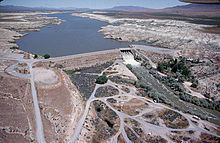Opening date 1936 Height 24 m | Status In use Type of dam Earth-fill | |
 | ||
Operator(s) Pershing County Water Conservation District Similar Lahontan Dam, Wild Horse State Recreatio, Pershing County Marzen H, Fort Churchill State Hist, Belmont Courthouse State Hist | ||
The Rye Patch Reservoir is a reservoir on the Humboldt River in the U.S. State of Nevada. It is located about 22 miles northeast of the town of Lovelock, and is managed by the Pershing County Water Conservation District. The reservoir stores water for the agricultural area surrounding Lovelock, which is at the far downstream reach of the Humboldt, near the Humboldt Sink. Since the Lovelock area receives a mere 5.76 inches of rain annually, agriculture requires irrigation, but the high variability of the Humboldt (which often runs completely dry) means that water storage is necessary for irrigation to be feasible.
Contents
Map of Rye Patch Dam, Imlay, NV 89418, USA
Swimming in rye patch reservoir 1
Rye Patch DamEdit
Therefore, in 1933 the Bureau of Reclamation decided to build the Rye Patch Dam to impound the Humboldt and create the reservoir. The dam was built between 1935 and 1936. A New Deal project intended to help fight the Great Depression, the dam was funded by the Public Works Administration and employed workers from the Civilian Conservation Corps. The dam was expanded in 1975-6, raising the dam three feet to provide the reservoir with more storage capacity.
Rye Patch Reservoir also includes the Pitt-Taylor Reservoirs, two off-stream storage basins that predate Rye Patch, as they were built in 1911 by a private venture of Lovelock farmers. However, they are less efficient than Rye Patch, losing much water to evaporation, so they are used only for additional capacity in high-flow years.
The reservoir has experienced sedimentation, a problem common to reservoirs in which sediment settles out of the river flow and decreases the capacity of the reservoir. A 1972 study estimated that the reservoir had lost 10% of its capacity to sedimentation since construction.
The reservoir has come under criticism, particularly from upstream users who accuse Lovelock farmers of attempting to monopolize the waters of the Humboldt for their own use. For instance, when the reservoir was nearly drained in 1992 to provide water to the farms, anglers at the Rye Patch State Recreation Area complained of a massive fish kill. The project has also been criticized for single-minded focus on irrigation and skewed cost-benefit ratios. Furthermore, a study by the Nevada State Museum in 1987 concluded that construction of the Rye Patch and Pitt-Taylor Reservoirs flooded archaeological and paleontological sites that showed evidence of prehistoric human habitation.
